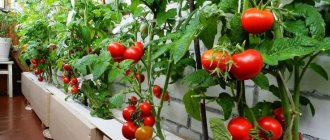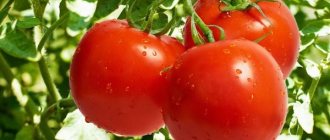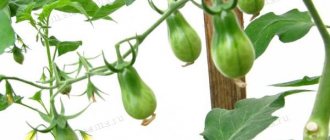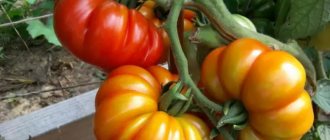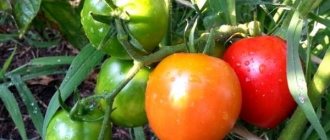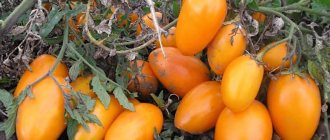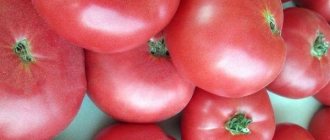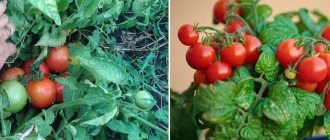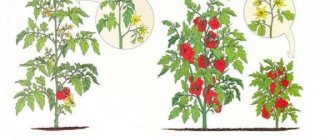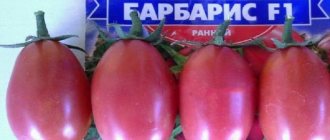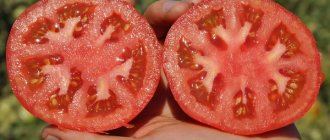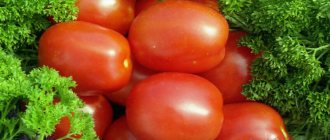Greenhouse conditions
The greenhouse is used to obtain crops earlier.
It should be made of glass or polycarbonate. And in those equipped with a heating system, cherry tomatoes are planted with seeds directly into the ground and harvested all year round. Growing in an unheated greenhouse is carried out using seedlings. Rules:
- The distance between bushes is 40−70 cm.
- Regular ventilation.
- Temperature: during the day - +22−25 degrees, at night - +16−18 degrees.
- Good lighting.
If the temperature rises to +30 degrees, the fruits do not set. You also need to make sure that there are no sharp fluctuations during the day.
Growing in a greenhouse
Balcony miracle
Tomato Balcony Miracle
This tomato is one of the shortest among cherry tomatoes - its height does not exceed 60 cm. The fruits are also distinguished by their miniature size - one of them weighs on average 50 g. This makes them popular in cooking, because such small tomatoes will be an excellent decoration for salads and winter preparations. And, unlike most other varieties, they can be frozen.
Biathlon
Tomatoes Biathlon
In unprotected soil conditions, this hybrid showed its best performance. It evokes special respect among many summer residents due to the fact that it produces fruits very early and in large quantities. So from one plant, with proper care, you can harvest more than 3 kg of small red tomatoes weighing 80-90 g.
Fruit yield is uniform and occurs 80-90 days after germination. Biathlon must be sowed in April, and transplanted into open ground on day 30-35. The bush grows approximately 80 cm in height, and for good yield it is necessary to leave no more than three stems on it. From one bush of Biathlon tomatoes you can collect up to 3 kg of fruit.
Arctic
Tomato Arctic
This is another variety of cherry tomatoes that produces very small fruits - their weight is only 15 g. Low-growing bushes reach a height of only about 40 cm. With proper care in open ground, it is possible to get up to 10 kg per square meter. m. An excellent feature of the Arctic tomato variety is its unpretentiousness - the plants tolerate drought, temperature changes, and soil salinity well. Doesn't need pinching.
6 punto 7
This hybrid was bred not so long ago, but has already proven itself quite well. It is resistant to many diseases, very productive and early ripening. The fruits have a regular oval shape and a bright red color. They are always characterized by a high content of dry substances, and therefore are suitable for whole-fruit canning. Their average weight is 20 g. The bushes are distinguished by an abundance of leaves, which protects them from sunburn.
Little Red Riding Hood
Tomato Red Riding Hood
The variety is early ripening, since after 95 days it can be harvested. The height of the bushes, as a rule, does not exceed 70 cm, and the average weight of the fruit is about 70 g. A distinctive feature of tomatoes is their very thin peel. When grown in open ground, you can harvest about 2 kg per bush. The red cap is resistant to many diseases, including late blight, and is also not sensitive to short-term temperature changes.
Cherry tomatoes (open ground varieties, low-growing) are grown to create unique-looking salads and preserves. They are incredibly healthy and extremely tasty. Children love them most of all.
Some summer residents, planting low-growing cherry tomatoes on their plots, primarily pursue the goal of decorating a certain area.
There is no need to deny yourself the pleasure of growing a beautiful plant that produces such valuable fruits.
We wish you success and great harvests!
Loading…
Small Cherry tomatoes have won universal recognition. Among their variety it is easy to choose a variety to suit every taste. Oval and round, orange and yellow, black and red - in salads and canned dishes they will become an excellent table decoration.
The temperature in the greenhouse should be 20-25°C during the day and 17-18°C at night. After germination, the temperature is reduced. Humidity is recommended 60-65%. The room must be ventilated regularly, especially during flowering.
The soil for Cherry is renewed annually. The land should be well warmed and fertilized, for example, with peat, humus or special mineral fertilizers.
Some gardeners advise leaving the prepared soil outside in frosty weather. This will partially kill the pathogenic microflora.
Seed preparation
It is best to sow tomatoes in a greenhouse in late March - early April. For better germination, seeds are soaked in clean, warm water for several hours.
Sow in small holes or grooves about 1.5 cm deep, cover with soil and irrigate with a spray bottle (so as not to wash away) with warm water.
Seeds, folded in a bag made of natural fabric, are dipped in potassium permanganate for 15-20 minutes. You can also use growth stimulants. To prepare them yourself you need 1 tbsp. Mix a spoonful of wood ash with 1 liter of water. The solution should be at a temperature of 25˚C. Planting material is placed in it for 24 hours.
Cherry is the fruit champion of vegetable culture
Cherry tomatoes are small-fruited, from 15 to 20 g, varieties . The main difference between Cherry and other tomatoes is expressed in the increased, almost 2-fold, content of dry nutrients and sugars dissolved in the intercellular juice. Regular, large-fruited and other small-fruited varieties of tomatoes cannot boast of such “richness”. In addition, large-scale breeding work has led to the appearance of Cherry tomatoes with the flavors of raspberries, strawberries, blueberries and honeydew melon.
Depending on the location on the site, you can choose tall, medium-sized or low-growing varieties. For varieties that will carry a decorative load on a personal plot, there is a choice:
- colors - greenish, yellow, pink, orange, crimson, all shades of red, burgundy, purple, black and striped;
- arrangement of fruits on the bushes - evenly over the entire surface, in grape clusters, tassels (5-6 pcs.), powerful “viburnum inflorescences” or long symmetrical vines;
- fruit shapes are traditionally round, plum-shaped, pears, lemons, lady fingers.
Features of agricultural technology
Growing Cherry tomatoes in open ground is no different from caring for ordinary tomatoes. Since most “cherry” varieties are of hybrid origin, they are distinguished by excellent germination, stress resistance, vigorous growth and abundant fruiting. Even in the central regions of Russia, 3-4 vines of indeterminate varieties have time to ripen, with 20-40 cherries on each.
To achieve a good result, it is very important to pay due attention to regular watering, mulching and avoid contact with open ground of leaves and fruits of tomato plants. It is important to remember - absolutely everything, regardless of the height of the bush, Cherry tomatoes require a garter, and for short ones you also need to allocate more space between the plants.
Culinary options
The first to appreciate the delicacy, fruit and design advantages of Cherry varieties were restaurateurs. Babies are used, whole or cut in half, not only in vegetable but also in fruit salads. They decorate dishes, desserts, alcoholic cocktails and drinks.
Read also: Onion sets: planting and care in open ground in autumn
Cherry varieties tolerate canning and pickling , and their internal properties allow you to create unique canned flavors.
Cherries turned out to be indispensable for hot chicken and fish skewers on wooden skewers. They made it possible to diversify the range of snack bars, gastronomic and fruit skewers, canapés and cakes for buffet receptions.
Cherry tomatoes have earned special respect from culinary experts for their extended shelf life and incredible keeping quality.
Pests and diseases
If you notice yellow stripes on the stem and fruits of the plant, and the leaves begin to curl, then most likely this is a viral streak disease; it appears due to lack of lighting. For prevention, you need to choose the right planting site and maintain the interval between bushes.
One of the most common ailments of this crop is late blight; it manifests itself in the form of brown spots of various shapes throughout the plant. To avoid this, you should not plant tomatoes next to potatoes. Treatment is carried out by spraying with drugs such as Barrier and Barrier.
Excessive humidity and too much fertilizer lead to fomosis, which manifests itself in rotting fruits. Dry spot is similar to late blight, but spreads a little faster. Spraying with special preparations is also necessary here.
Seedlings and young bushes are often damaged by blackleg, the fight against which consists of moderate watering and mandatory ventilation of the room in which the tomato seedlings are located.
Among the pests that can attack tomatoes are:
- spider mite,
- whitefly,
- slugs,
- mole cricket,
- wireworm
But at the moment there are many drugs that can easily help get rid of them and preserve the harvest.
Planting seedlings in open ground
From the second half of May, you can begin to plant cherry tomato seedlings in a summer cottage plot prepared for this. The main condition for planting is the absence of frosts, the crop tolerates them very hard, and at a temperature of -4 the plant immediately dies.
The bushes are formed at a sufficient distance from each other, this is approximately 70-80 cm. If they are distributed more often, shading will occur and the level of fruiting will decrease.
You need to plant it in a shallow, slightly moistened hole, do the work very carefully, and try to do less damage to the delicate roots of the plant. It is advisable to deepen the tomato to the first two side leaves. At the end of planting, lightly compact the soil and moisten it.
In the future, refrain from watering until the seedlings are established. If the weather outside is very hot, then the young bushes can be darkened a little.
An ideal place for growing cherry tomatoes would be a place with plenty of light and without excess moisture; the soil should be loose with neutral acidity.
The best predecessors are:
Under no circumstances should you plant tomatoes after potatoes. Neighboring crops can be any plants, provided that they do not create unnecessary shade for the tomatoes.
Characteristic
By studying the characteristics of modern cherry tomatoes, you can understand that they are hybrids. They are resistant to sudden temperature changes regardless of the time of day. They develop in countries with hot climates. They are not afraid of moisture deficiency.
Depending on the length of the stems, they are divided into three types:
- determinant - short stature;
- semi-determinant - average height;
- indeterminate - tall.
In 2015, the hybrid was included in the State Register. There it is called "Cerrinegro".
Cherry Negro F1 tomato from Semko is an indeterminate bush that does not stop growing when the fruit begins to ripen and can reach two meters in height. The harvest ripens early - 85-95 days after seedlings appear. The brushes strewn with tomatoes contain 15-20 of them and look like grapes.
The dark hue of the fruits is due to anthocyanins - substances that give eggplants their purple color. Anthocyanin is a natural antioxidant that prevents disease and slows down aging.
The general characteristics of the Cherry Strawberry F1 tomato fruit are very important. As the name suggests, tomatoes are similar in appearance to strawberries. The shape of the fruit is unusual for tomatoes, heart-shaped. Fruiting is abundant.
A variety with early fruit ripening. You can harvest the crop within 100–105 days after the seedlings emerge.
Ripe tomatoes store very poorly. Therefore, immediately after harvesting, they must either be processed or consumed fresh. The disadvantage of this variety is that the fruits cannot be used for making tomato pastes and juices. Because they have a high dry matter content.
Those gardeners and vegetable gardeners who planted the variety on their plots were satisfied with the results. In addition to the high taste of the fruit, the Cherry Strawberry hybrid has a very attractive appearance. It’s impossible to take your eyes off the bushes strewn with bright red tomatoes.
About the Cherry tomato variety
The homeland of the species is considered to be South America and Peru. Now you can already find these tomatoes in our garden plots. And they are all different shades and shapes .
Peru is the official birthplace of the cherry tomato
Description of the variety
Varieties of this species can be of different heights from 358 cm to 2 m in height. The stems are elastic green. The leaf blades are green and have the usual tomato shape. Fruits may vary in color :
The shape of the fruit is round, oval, highly elongated elliptical.
All Cherries have a small berry weight of 15-35 g . depending on the variety.
Characteristics of Cherry
These factors are the advantage to plant 5-6 cherry bushes on your site.
Seedling
It is recommended to plant seeds in early April; planting in the ground is carried out in the first half of May. The harvest directly depends on the quality of the soil; it must be sufficiently nutritious and loose. The most suitable mixture is considered to be a mixture of peat, sawdust, and humus. Fertilizing the soil, which should be mixed with manure, also plays an important role. A preliminary procedure is carried out to disinfect the soil with a solution of potassium permanganate heated to seventy degrees.
The height of the side of the container for planting seeds must be at least 15 cm; these conditions are considered optimal for the formation of roots. A moist substrate should be poured into the bottom of the container, in which furrows must be made; the seed placement depth reaches 3 cm. When planting tomatoes of different varieties, separate containers are used.
The seedlings should be installed in a lighted place, the duration of daylight should be at least 14 hours, and additional lighting should be provided if necessary. Seeds germinate at a temperature of 30 degrees, so the box should be moved closer to heating appliances. After emergence of seedlings, the temperature should be maintained at 20-24 degrees; reducing it to 16 degrees can lead to a slowdown in the formation of ovaries.
Rules of agricultural technology taking into account the region
Most varieties of cherry tomatoes are acclimatized for all Russian regions. In the north they are grown by seedlings, and in the south the seeds are sown in the ground. In the central regions, up to 3-4 vines ripen per season
When planting, you should pay attention to watering, mulching the soil, and preventing fruit from contacting the soil. The technology of agricultural work consists of the following steps:
- Planting grains without soaking in containers, pots or flowerpots.
- Proper soil preparation. It is necessary to mix chernozem with sand in proportions of 3:1.
- The level of the holes is shallow and subsequent watering is mandatory only with warm water. It is convenient to make grooves with a pencil.
- Creating a greenhouse effect using cling film.
- Removal of polyethylene after the appearance of the first shoots - on the 5th day after planting.
- Mandatory thinning and picking of seedlings after 5-6 leaves have appeared.
- Daylight control when growing on a windowsill. Phytolamps need to be turned on for 10-12 hours.
- Creating support in open ground conditions. The transplant should be carried out before the formation of the flower ovary (after 30 days).
- Periodic loosening and weeding. Fertilizers are applied once every 14 days.
When pinching, it is important not to remove the leaves - this reduces the yield. Fruits appear after 2-4 months
They ripen quickly, and the bush itself bears fruit for about six months.
The best varietal cherry tomatoes and hybrids
Reviews from vegetable growers often help you choose the best cherry tomatoes for open ground. The most widely recognized cherry hybrids are “Ildi F1”, “Honey Drop F1” and “Yellow Date F1”. They say about the Sweet Cherry tomato that it is the sweetest and very productive. Cherry "Barberry" has received wide recognition in the Siberian region.
Red caviar
The tall variety has a long stem up to 2 m in height. Be sure to have a stepson and fasten it to a support. Fruits best when formed with 1 stem. The spherical small red fruits weigh a maximum of 20 g. The clusters are large, each containing up to 40 tomatoes. The yield of 1 bush reaches 2 kg.
In terms of ripening time, the indeterminate cherry variety belongs to the mid-early tomatoes. The plant grows about 2 m in height. Be sure to pin and secure to the support. The highest yield is observed when the bush is formed with 2 or 3 stems. Up to 12 small tomatoes are tied in clusters. The elongated, finger-shaped fruits weigh no more than 25 g. The red, fleshy pulp is sweet and tasty.
Chocolate bunny
The indeterminate cherry tomato variety is considered the best due to its high yield. A powerful plant with a spreading crown grows up to 1.2 m in height. Stepchildren grow rapidly, so you need to have time to remove them. Beautiful plum tomatoes turn chocolate brown when ripe. Small fruits store well, are suitable for canning, and can be dried.
The “Chocolate Bunny” variety is presented in the video:
Ira F1
Indeterminate early cherry tomatoes begin to bear fruit after 90 days. The intensively growing bush can stretch up to 3 m in height. Many unnecessary branches grow from the main stem, which must be removed in a timely manner. High yields are achieved by forming the crop with 2 or 3 stems. The hybrid in open ground is capable of bearing fruit before the onset of the first frost. Small fruits in the form of a cube with a sharp tip weigh up to 35 g. The red dense pulp is very tasty. When planting 4 plants per 1 m2, 15 kg of harvest is obtained.
Having considered the rating of the best cherry tomatoes, it is time to read reviews from vegetable growers. Often, such tips help you choose the right variety for growing.
Advantages and disadvantages
Growing cherry tomatoes has its pros and cons. The advantages of mini tomatoes include:
- friendly ripening is a feature of bunch tomatoes;
- the ability to store dense-skinned cultivars for more than a month. And with additional ripening, such tomatoes are picked in parts for eating, the rest remain in the bunch until fully ripe and continue to lie in a room where the temperature does not drop below +5–8 C°, up to 60 days;
- cold resistance - varieties of domestic selection bear fruit in open ground until the first frost;
- Possibility of use in garden design and home flower beds.
The cherry assortment includes many potted varieties that are distinguished by their impeccable yield.
Scientists say that it is small-fruited tomatoes that are rich in lipids and sugars. These vegetables help absorb vitamin D, which is probably why winter recipes for fresh salads often include cherry tomatoes.
Flaws:
- often fall off, especially if left on bushes;
- fruits crack - this is the scourge of small-fruited tomatoes, so clusters that are not yet fully ripe and varieties that are least susceptible to this scourge are left for storage;
- despite the fact that in general cherry tomatoes get sick less often than ordinary tomatoes, they are highly susceptible to some nightshade diseases (blight rot, late blight, bacteriosis);
- tall varieties require garter.
Cherries require tying the stems and fruiting bunches to a reliable support, regardless of whether the plants are planted in beds or in a greenhouse
Review of low-growing cherry tomatoes
So, it’s time to move on to a review of low-growing cherry tomatoes, or scientifically, determinate ones. These crops bring the earliest harvest. It is optimal to grow low-growing cherry tomatoes in open ground; only immediately after planting, the seedlings are covered with film to acclimatize them.
Cherry Blossam F1
The hybrid has a powerful bush structure and bears mature cherries in 100 days. A determinate plant can grow up to 1 m in height. For stability, the bush is fixed to a wooden peg. High yields can be achieved by forming 3 stems. Small, spherical red tomatoes weigh only 30 g. The flesh is dense and sweet. Thanks to the strong skin, the tomato does not crack during canning.
Basket on the window
The low-growing variety is intended for open cultivation. However, a small bush with a height of only 40 cm has made the crop popular for growing in a window. The variety is very early ripening; after 80 days, mature bunches of tomatoes can be harvested. The fruits ripen together, all at once. A maximum of 10 small tomatoes are tied in clusters. The weight of the vegetable is only 30 g. The tasty round fruits are famous for their decorative properties. A super-determinant bush does without pinching and fastening to a support.
Granddaughter
This delicious cherry tomato variety is capable of producing small fruits weighing 20 g, as well as larger specimens weighing up to 50 g. The bush grows no more than 50 cm in height and is capable of holding the harvest on its own without tying it to a support. The tomatoes are round, slightly flattened.
Cranberries in sugar
An early ripening decorative variety intended for any type of cultivation. A determinate plant does not need to be tied to a support. The spherical tomatoes of a rich red color are very small, weighing on average 20 g. The culture adapts to bad weather conditions.
Irishka
Varietal low-growing cherry will bring an early harvest of ripe tomatoes in 87 days. The plant grows to a maximum of 50 cm in height. Optimal planting in the garden. The advantage of the variety is its long fruiting, during which the plant produces small red tomatoes weighing 30 g.
Honey candy F1
The hybrid is considered a mid-early tomato with fruit ripening in 110 days. The open-air crop bears fruit well in the south. For the middle zone, planting under film is recommended. The plant grows up to 80 cm in height and is weakly overgrown with foliage. Up to 6 clusters with up to 28 small tomatoes are tied on the stem. The bush is formed with 2 or 3 stems and secured to a support. Plum-shaped cherry tomatoes weigh only 30 g. The dense, orange-colored fruits are delicious when pickled and preserved.
Coin
Standard culture refers to ultra-early tomatoes that ripen in 85 days. The bush does not require gartering or pinching. Round yellow tomatoes grow very small, weighing up to 15 g. The fruits form and ripen together before late blight spreads.
Button
An ornamental early variety of cherry tomatoes will bear the first harvest in 95 days. The low-growing bush grows to a maximum of 60 cm in height. The shape of the tomatoes resembles small cream. The fruits are smooth, dense, and do not crack. The weight of a mature vegetable reaches 40 g.
Children's F1
The standard low-growing crop yields a harvest in 85 days. The hybrid is grown in the garden, under cover and in the house. The bushes grow small, about 30 cm in height, sometimes they can stretch up to 50 cm. Elongated red tomatoes are tied in tassels of 10 pieces. The weight of 1 tomato is no more than 20 g. The culture adapts to heat, drought, and cool weather. With good care, you can take up to 7 kg of vegetables from 1 m2.
The video talks about cherry tomatoes:
For the balcony
It's no secret that low-growing cherry tomatoes can be grown indoors, on a balcony or windowsill. For this, breeders have developed a number of special varieties that have a compact root system and resistance to lack of light. Among these varieties it should be noted:
Minibel
A wonderful variety of low-growing cherry tomatoes, which allows you to harvest more than 1 kg of vegetables from one bush. Compact bushes, no more than 50 cm high, can be successfully grown indoors. The container for them can be a small container or pot with a volume of just over 1.5 liters.
The unpretentious, ornamental plant “Minibel” begins to bear fruit abundantly within 90 days after sowing. The harvest will delight even the most sophisticated gourmets with its taste. Small vegetables weighing up to 25 grams. very sweet, their skin is tender. You can grow such tomatoes indoors all year round, which allows you to always have a natural, tasty decoration for dishes and a natural source of vitamins on hand.
Features of low-growing varieties
Determinate varieties of tomatoes are suitable for cultivation on a windowsill, balcony, or in open ground conditions. Low bushes (up to 50 cm) are unpretentious and do not require pinching. To prevent bushiness, only the branches of the plant are cut off - removing leaves will reduce the yield.
Cultivation rules
When growing low-growing tomatoes, it is important to observe a number of conditions:
- ensure that the fruits do not touch the soil;
- plant seedlings in March-April;
- dive at the stage of the first erect leaf;
- plant in the ground in May, when the soil has finally warmed up.
Determinate plants are early ripening, they ripen 70-80 days after planting. Up to 20 fruits can form on one brush.
Variety selection
Due to its compact size, the crop does not need to be replanted from flower pots or hanging baskets. Among the varieties of mini-tomatoes, gardeners distinguish:
- Pygmy. Ripens 85-93 days after planting. Grows in open areas, in a flower pot, on a balcony, used for patio decoration or in greenhouses as a sealant for tall bushes. Red round fruits with a smooth surface have a sweet taste and are used for salads and canning. Up to 4.7 kg of tomatoes are harvested from 1 square meter;
- Bonsai. A dwarf type of cherry with a bush height of up to 30 cm. 85-90 days pass from the moment of germination to fruit formation. The round fruits weigh about 25 g. The variety is decorative, suitable for planting in flower pots. Up to 0.5 kg of vegetables are collected from one plant;
- Balcony miracle. A semi-spreading crop that bears fruit 85-90 days after planting. The bushes reach a height of 40 cm. Smooth, round, with bright red skin, the fruits ripen evenly. The tomato is suitable for canning and fresh consumption. Takes root well on a loggia in a flowerpot or flowerpot;
- Garden pearl. Belongs to the ultra-early varieties (ripens on the 93rd day after planting). Low, up to 40 cm, bushes are creeping. In one season, up to 500 g of sweet vegetables of a transparent pink color are formed on them. The fruiting period varies in length. Tomatoes are used for decorating dishes, whole canning or salads;
Homemade tomatoes have excellent taste. The fruits can be collected in clusters or clusters.
Rating of varieties suitable for open areas
Two types of crops are popular in summer cottages and gardens - early and mid-early. The best varieties presented below are sown in March.
Description of mid-season varieties
From the appearance of sprouts to full ripening, 106 days pass. Regardless of the variety, tomatoes are distinguished by their juicy taste and rich vitamin and mineral composition. The following plants are popular in gardens:
- Galapagos. Fruits with a glossy red surface are collected in clusters, up to 20 pcs. on each one. In the middle zone, the variety is cultivated in a greenhouse, and in the south - in open ground. Small fruits weigh 25 g, have a sweet taste, and are intended for decoration of dishes, salads and canning;
- A gardener's delight. The bushes are medium-sized - about 130 cm. The indeterminate plant was selectively bred and adapted to open ground conditions. Round fruits weighing 30-35 g are distinguished by their bright taste, red skin and juicy pulp. Can be used for whole fruit sealings, preservation, decoration and vegetable cuttings;
- Cherry Valentine. It is grown in open ground in the south and in greenhouses in northern climates. Tall bushes - up to 2 meters require pinching and gartering. Small round fruits are collected in clusters, have a pink-red color, weigh up to 25 g and have a dessert taste. Used fresh or canned;
- Bulls-eye. The crop has a stem height of 180 to 200 cm, so it is tied up and pinched. The molded bush is suitable for greenhouses and open ground. It produces round fruits with a glossy smooth red surface. Tomatoes weighing from 15 to 30 g are collected in brushes. The number of fruits in one bunch can be 40 pieces. The variety is chosen due to its decorative properties, disease resistance and versatility of use.
- Bing Cherry. A rare hybrid variety created by Tom Wagner - characterized by disease resistance and yield. Suitable for both open ground and greenhouses. The fruits have an interesting color - the upper part is painted in a lilac-pink hue, and anthocyanin can be seen on the shoulders. Tomatoes weigh up to 80 g and are distinguished by a pronounced aroma and sweet taste of the pulp.
- White nutmeg. Exotic, carpal, tall, productive variety. For growing in open areas, it is optimal only for the southern regions. The height of the bush reaches about 2 m. The fruits are characterized by an oval-pear-shaped shape, a flat, smooth surface. At the stage of biological ripeness, the skin becomes yellow. The pulp of universal tomatoes is juicy and sweet. The plant is versatile – suitable for processing, corking and salads. About 4 kg of fruits are collected from one bush;
- Amethyst cream-cherry. A rare variety that is cultivated in greenhouses and garden plots. At the ripe stage, the rounded fruits are cream-colored with a small amount of anthocyanin. They are consumed fresh or canned. The advantage of the variety is good keeping quality;
- Galapagos. A raceme variety that is grown in gardens only in the south. The glossy tomatoes with a red surface weigh about 35 g each and grow in clusters. The fruits are canned and eaten fresh. About 3.5 kg of vegetables are harvested from one bush;
- Dr. Green Frosted. An interesting universal carpal variety. Round tomatoes are colored green and weigh approximately 25 g. The disadvantage of the crop is the difficulty of determining biological ripeness. Tall bushes, more than 2 m, are tied up;
- Green grapes. Tall cherry, reaching 1.5 m in height. Round, smooth, medium-dense tomatoes are collected in bunches. The surface color at the maturity stage is yellow-green. The pulp has an unusual fruity taste and pronounced aroma;
All of the listed mid-early varieties bear fruit 2-4 months after being placed in open ground.
Specifics of early cherry tomatoes
Determinate and indeterminate crops take root well in vegetable gardens, summer cottages, and personal plots. Low or tall cherries are grown without soaking the seeds, but they must create a greenhouse effect using film. Gardeners prefer cherry tomatoes, all varieties of which are intended for open ground - the crops are mainly low-growing, ripening in 95-100 days:
- Red cherry. A semi-spreading bush with a small number of leaves reaches a height of about 1.9 m. The small fruits are characterized by a red surface, weigh approximately 15-20 g, have a sweet taste of the pulp and are suitable for preservation. The variety gives a good harvest with drip irrigation;
- Yellow cherry. The average number of branches and smooth yellow fruits with sweet pulp attract vegetable growers. They are canned, eaten fresh and in salads. When growing this variety, note that fruits grown in the shade have a slight sourness. 1 kg of fruit is collected from one plant;
- Cherry. Liana forming brushes. One bunch contains from 20 to 50 fruits. Tomatoes are distinguished by their round shape, glossy red skin and sweet taste. Used for decorating dishes and preparing preserves;
- Grape. An ornamental plant 1.5 m high. The clusters contain up to 30 fruits, the size of a cherry. At the stage of biological maturity they become bright red, translucent with a glossy surface;
- Barberry. The fruits of a tall, early-ripening plant are collected in clusters of 70 pieces. Tomatoes are distinguished by their oval shape, pink dense flesh and excellent taste. Suitable for canning or salads;
- A curiosity. An early-ripening productive crop that produces red-brown, round-shaped fruits. Juicy tasty tomatoes weighing 20 g are canned and added to salads.
It is necessary to sow early varieties 60-65 days before placing them in open ground. The optimal number of plants per square meter is 3-4 pcs.
Growing in a greenhouse
Growing Cherry in a greenhouse is not much different from growing large varieties of tomatoes. To harvest crops all year round, greenhouses must be heated. They are made of glass or polycarbonate and equipped with a heating and lighting system.
Temperature and humidity
The temperature in the greenhouse should be +20-25°C during the day and +17-18°C at night. After germination, the temperature is reduced. Humidity is recommended 60-65%. The room must be ventilated regularly, especially during flowering.
Priming
The soil for Cherry is renewed annually. The land should be well warmed and fertilized, for example, with peat, humus or special mineral fertilizers.
In autumn, dig up the soil and add humus or compost; norm: 6-8 kg per 1 sq. m. Spring soil preparation includes the application of urea (nitrogen fertilizer) - 12-15 g per 1 sq. m. m. Usually 20-30 g of potassium chloride and about 35 g of superphosphate are added to it.
Some gardeners advise leaving the prepared soil outside in frosty weather. This will partially kill the pathogenic microflora.
Seed preparation
It is best to sow tomatoes in a greenhouse in late March - early April. For better germination, seeds are soaked in clean, warm water for several hours.
Sow in small holes or grooves about 1.5 cm deep, cover with soil and irrigate with a spray bottle (so as not to wash away) with warm water.
Processing of planting material
Seeds, folded in a bag made of natural fabric, are dipped in potassium permanganate for 15-20 minutes. You can also use growth stimulants. To prepare them yourself you need 1 tbsp. Mix a spoonful of wood ash with 1 liter of water. The solution should be at a temperature of +25˚C. Planting material is placed in it for 24 hours.
Watering and fertilizing
Watering is carried out in the same way as when planting in open ground. Tomatoes are fed with both purchased fertilizers and those made independently.
For example, nettles and dandelions are poured with water and left to ferment, stirring twice a day. The solution is ready when it has changed color and the grass has settled to the bottom. The infusion is filtered and the seedlings are watered with 1 liter per bush.
Support needed
Most varieties preferred for greenhouses are quite tall, so they certainly need to be tied up. This will not only support the stem during fruiting, but will also protect the tomato bunches from contact with the ground.
Unheated greenhouse
If the greenhouse is not heated, the temperature in it for sowing seeds for seedlings should be +20-25°C. The seeds are planted in special containers, covered with film until the first shoots appear, and after 2-3 true leaves appear, they are planted in the ground.
If the temperature allows, you can sow the tomato directly into the ground. The picking procedure is carried out in the same way.
Variety "Black Cherry"
Ripens very quickly - after 65 days.
Designed for outdoor use. The plant is indeterminate, very tall (up to 3.5 m), grows on one trunk.
The fruits are spherical, purple, almost black, sweet taste, very juicy.
They reach a weight of 10-30 g. It can be used for assembly and maintenance.
In warm climates, you can put it directly into the ground, skipping the seedling stage. If the bushes grow in this way, then immediately after laying the seeds it is necessary to install metal arches over the row of seeds, and then stretch the plastic film over these arches.
If the cuttings have been grown, there are no changes in the process. The planting plan is also standard - 50x70 cm.
Maintenance is also normal. Timely watering, regular feeding, pinching and gartering will help the plants grow better.
Cherry - what are they?
Cherry tomato fruits weigh no more than 35–40 g, and the smallest ones weigh from 5 to 15 g. A distinctive feature of small tomatoes, the fame of which has spread throughout the world over several decades, is their rich taste and high sugar content in the pulp.
The leaf blade of these tomatoes is also very decorative - with carved edges, color - from dark green to pistachio.
This variety of tomatoes bears fruit well both in the ground and in covered greenhouses; among them there are dwarfs up to 50 cm in height and medium-sized ones more than 1 m in height.
Home cultivars are less productive, but they can be grown without problems as a potted crop on a veranda, balcony or windowsill all year round
Tall exhibits, reaching 2.5–3 m, especially when forced in greenhouses, are capable of growing massive fruit clusters, the length of which reaches from 20 to 70 cm, and the weight varies from 2.5 to 6 kg.
It’s okay that a tomato is just one bite, but the whole family can enjoy one bunch
Mini-fruits are convenient to eat, they can be used to decorate salads, sandwiches and even sweet pastries; the pulp makes an amazing sauce, lecho, and cherry tomatoes can also be dried and baked, salted and frozen whole or cut into halves.
Cherries are delicious marinated in spicy and sweet sauce, in tandem with olives and black olives, with herbs and spices
Pea tomatoes are used for serving one by one or in whole bunches; canapés are made from whole multi-colored fruits; they are placed in soups and stews.
Some cherry varieties are sometimes difficult to distinguish from berries: the bunch, the shape of the berries, and the color are very reminiscent of grapes
Application options for cherry tomatoes
Miniature tomatoes are used to decorate salads. Their consumption in raw form does not harm health if there is no individual intolerance. Allergic reactions to this vegetable are rare.
Cherries are often used to make sandwiches, sandwiches, and added to pizza and other dishes. In recent years, a new trend has emerged - roasting vegetables. It can be used:
- fresh;
- pickled;
- dried;
- dried;
- as a filling.
Cherry tomatoes are sweet. Some varieties taste like some vegetables and fruits. The product has low calorie content and is suitable for those who adhere to proper nutrition or are on a diet.
An excellent early variety for snacks is the Zest tomato: description of tomatoes and characteristics
Tomato Izyuminka is an excellent early ripening salad variety. Already in July, low bushes are covered with dense clusters consisting of five or six heart-shaped, raspberry-colored tomatoes.
| Height | Landing location | Ripening time | Fruit color | Fruit size | Origin | Fruit shape |
| short | Open ground | Early ripening | Reds | Small | Variety | Heart-shaped |
Description and characteristics of the variety
The variety is early ripening and begins to bear fruit on the 105th day after germination. The plants are determinate, 55-60 cm high. Despite their short stature, it is better to pin the bushes and tie them up, since due to the abundance of brushes and leaves they lie down.
The shape of the fruit is heart-shaped, the tomatoes are smooth and dense, green when unripe, pink when ripe. There are 3-4 nests inside with a small amount of seeds. Average weight 50 g.
Country of origin, year of registration
The Izyuminka tomato was bred in Russia. The variety was registered in 2008, agro originator, Moscow.
Growing regions
The variety can be grown in any region, in open ground and in a greenhouse. It is suitable for canning whole fruits, pickling and preparing summer vegetable salads.
Advantages and disadvantages
- almost never gets sick;
- high productivity;
- bears fruit throughout the summer;
- great taste.
Possible problems:
- does not tolerate frost;
- needs a garter.
Features of cultivation and storage
The peculiarity of the cultivar is its friendly shoots. Seeds, even after long-term storage, have high germination energy and do not require pre-sowing treatment. They can simply be disinfected in potassium permanganate for 20 minutes and then washed in clean water.
Izyumina fruits are not suitable for long-term storage. When ripe, they will last no more than 5-7 days in the refrigerator.
Planting and care
In mid-May, the seedlings are transferred under film, and in early June - into open ground. Seedlings should have 5-7 true leaves and the first brush before planting. Plants are planted according to a 50 by 40 cm pattern. Fruit harvesting begins in July and continues until the beginning of September.
Growing Cherry Tomato
This is one of the most delicious tomatoes that grow in our gardens. Its remarkable feature is the small size of the fruit and the sugary taste.
How to grow cherry seedlings
To do this, you need to remember the important points of growing healthy seedlings:
- Seeds are planted in fertile and loose soil.
- To ensure friendly shoots, the container with the planted seeds is covered with glass.
- The air temperature in the room should reach 27 degrees Celsius .
- Where the containers with future seedlings are located, there should be enough sunlight so that the sprouts, as they grow, do not stretch out and become thinner.
You need to take care of the right location and good care of the growing tomato seedlings.
What substrate is required for seedlings?
The soil for growing Cherry tomatoes must be nutritious. And not only in containers for seedlings. The land allocated for growing tomatoes should be well fertilized using complex fertilizers .
Read also: Currant planting and care in open ground in the Urals
Or you can compose it yourself , taking everything in equal proportions:
Whatever the soil, it should be disinfected before planting seeds.
To do this, it is spilled with a bright pink solution of potassium manganese. Or you can use another method of disinfection - calcine the prepared soil in an oven at a temperature of 200 degrees. 20 minutes.
Complex fertilizer for tomato
Landing dates
In order for fruiting to occur at the beginning of summer, it is worth taking care of planting seedlings. To do this, at the end of February - beginning of March, the seeds are sown in containers filled with fertile soil.
Water and cover with glass. If you plant under glass, this will help create greenhouse conditions and the seedlings will be more friendly.
Where to plant
Already in separate cups they are grown before being transplanted to a permanent place of residence.
It is necessary that the containers where the seedlings will be planted have holes to drain excess water.
Transplanting seedlings into open ground
The grown seedlings have a healthy appearance - green leaves, height 15-20 cm, thickened stem. Before transplanting seedlings into open ground, they are hardened. To do this, over the course of 10 days, she is gradually accustomed to the open air. First they take it out for a couple of hours, and then you can leave it overnight.
A little wood ash is added to the dug holes, spilled with water and tomato seedlings are planted. After which they are covered with earth and the soil is compacted around the stem. If the region already experiences stable warm weather, the seedlings are mulched with mowed grass .
Cherry tomato care
Basic rules for caring for tomato bushes:
- Watering;
- Fertilizer;
- Loosening;
- Weed removal.
When the seedlings grow, you will need to form a bush into one stem. To do this, the emerging stepsons are twisted once every 7 days. If the Cherry variety is tall , then you will need to make a support for it and, as the bush grows, tie it to this support so that it does not break under the weight of the filling hearths.
Weeds interfere with the cultivation of any tomatoes
When planting the Cherry variety, it is worth making a distance between seedlings of 50 cm.
Protection from diseases and pests
Sometimes you can notice the following diseases on tomatoes:
- Tomato mosaic - when this disease appears, the bush is removed and destroyed outside the garden bed;
- Late blight - sprayed with fungicides and, for the sake of prevention, those leaves that are located near ripening tomatoes are torn off;
- Cracking of fruits means that the bushes are receiving too much moisture and watering should be reduced.
It is easier to prevent diseases than to then treat the entire bed of planted tomatoes.
Harvesting
Harvesting should only take place when the fruits are fully ripe. Unripe fruits have a rather sour taste. When overripe, the fruits fall off.
The difference in growing methods: Hanging and seedlings
The seedling method was described above, now let’s take a look at the hanging method. To do this, the Cherry variety must have the following data :
- A variety with good branching and without stepsons.
- The branches must be flexible so as not to break under the weight of the fruit.
These tomatoes are sown immediately in pots intended for hanging on open terraces. The seed planting date is early May.
Under such conditions tomatoes will ripen before the onset of cold weather , later they are brought into the house and they continue to bear fruit, although not abundantly as in the summer, but tomatoes will still appear.
The varieties must be self-pollinating.
Not every type of Cherry can be grown in pots
Cherry tomatoes are the type of tomato that you should try to grow in your garden. Because they have a beautiful appearance and a high sugar content in their fruits.
Seedling method
Sowing of seeds begins in early April. By this time you need to prepare the substrate. It should be loose and fertile. To prepare it, humus, peat and sawdust are used. Manure is used as fertilizer, and disinfection is carried out with a solution of potassium permanganate. The soil mixture is also enriched, per bucket, with superphosphate (60 g), potassium sulfate (20 g) and two cups of wood ash.
Talking about how to grow cherry tomatoes when there are few seeds, professional gardeners say that they plant them in seedlings without picking. Seeds are placed in separate cups, two each. The substrate is poured halfway and then added as needed. After three weeks, weak seedlings can be removed. This method is good because picking is not required later. And when there is a lot of planting material, seedlings are grown using a different algorithm.
Instructions:
- The boxes are filled with soil mixture.
- Seeds are distributed at intervals of 1.5 cm.
- Sprinkle with a layer of soil 0.6 cm thick.
- The container is covered with film and placed in a dark place.
- At the first stage, the air temperature should be +23−25 degrees.
- On the 5th–7th day, the container is placed on a lighted windowsill.
- During the week, the seedlings are kept at +10−15 degrees during the day and +8−10 degrees at night.
- After a week, the seedlings are provided with a temperature of +20 degrees.
Seedling care
Seedlings need moderate watering and spraying. Picking into cups is carried out at the stage of two true leaves. The irrigation regime is changed at the time when five leaves appear on the seedlings: the soil is moistened every 4 days.
For full development, young plants require good lighting (14-16 hours). In the dark, seedlings need to be illuminated with a phytolamp.
Transplanting to a garden bed
Before planting in the ground, seedlings are accustomed to cool conditions. At the end of April, they begin to take the boxes out onto the balcony or terrace. Leave them for 15 minutes, and gradually increase the time every day.
The tomato bed should be lit and warmed up. Predecessors can be carrots, beans, onions, cabbage, radishes, and beets. And physalis, tomato, potato, eggplant and pepper suck nutrients from the soil, so nightshades are sown in this place no earlier than four years.
They begin to prepare the soil in the fall: apply humus (60 l/m2), phosphorus and potassium fertilizers (20 g/m2 each). And in the spring, the beds are loosened and fed with a nitrogen-containing nutrient mixture (10 g/m2). Transplantation is performed in warm, damp weather.
Description of the Gogoshary variety and technique for growing sweet peppers
Algorithm:
- Prepare holes 10 cm deep with an interval of 40 cm. The row spacing is half a meter.
- Pour 2 liters of warm water into the holes and immediately plant the seedlings.
- The soil around the seedlings is carefully compacted and mulched with humus.
The seedlings are tied to supports and a greenhouse is constructed from arches and non-woven material.
The best low-growing cherry varieties
Pygmies - 1-2 liters of pot is enough for growing a pot. The stem is up to 25 cm tall, the fruits are round, red, sweet, very decorative. Can be planted in balcony boxes, no need for pinching.
The balcony miracle is a shrub up to 50 cm high; it cannot be grown, but if the load is heavy, the crop will have to be tied up. Round red cocktail-type fruit weighing 30-50 g, early.
Florida Petit is a small bush up to 25 cm tall, with a round red sweet fruit. Can be used for pool culture.
Bonsai is another child who comes to the window and balcony. Red sweet and sour fruits of medium size and very short clefts.
Pizzeria is taller than the previous ones, up to 70 cm with round red fruits for universal use, on average 107–110 days from germination to fruiting. It is distinguished by its fruit skin and friendly harvest. Up to 20 fruits per cluster.
Grigorashik is a variety of Siberian selection, judging by its appearance, similar to a balcony miracle.
Cherry tomato varieties for greenhouses Generally, they are also suitable for outdoor areas, where seed producers recommend growing them in trellis selection. In the greenhouse, special attention should be paid to stepsons, since many people note their tendency to thicken the bushes if you do not have time to remove the stepsons. Places that are needed even a little more than the usual ones by individuals. Something to note: Cherries should be planted on at least a few bushes, but should not be planted on them like pickle or salad varieties. They are great for fresh consumption, for pickling and for salads, but the cherry tree yield is not as large as for regular tomatoes due to the low weight of the fruit, although the number of well-cared for fruits is quite significant. Therefore, it is better to use it as a sealant in jars with large tomatoes for pickling cherry tomatoes, and for salads it is better not to take the smallest ones, but rather cocktail varieties and hybrids with fruit weighing 30-50 g, such as Black Moor, Phenicia. Cherries, which have tiny fruits, are best for fresh consumption. New - Aelita Gold F1 bead with small cherry-yellow fruits weighing 10-15 g, of which 15-25 pieces in a brush. Midway through the season, the tomato was declared resistant to fusarium, cladiospora and apical rot. Another new variety is the bicolor wonder. It will be of interest to lovers of varieties with an unusual flavor.
New - Aelita Gold F1 bead with small cherry-yellow fruits weighing 10-15 g, of which 15-25 pieces in a brush. Midway through the season, the tomato was declared resistant to fusarium, cladiospora and apical rot. Another new variety is the bicolor wonder. It will be of interest to lovers of varieties with an unusual flavor.
Tomato pepper F1. Ultra early hybrid from, the period from germination to ripening is 90-97 days. Designed for glass and film greenhouses. The plants are indeterminate, height 1.8-2.0 m. The fruits are cherry, round, weighing 18-20 g, very uniform. The hybrid is resistant to TMV, Fusarium, Cladosporia.
Tomato Sweet pearl. A variety with abundant fruiting. Early ripening, from complete germination to the first fruit harvest 95-100 days. Recommended for greenhouses and open areas in grids. The plants are indeterminate, height 1.8-2 m. The tomatoes are round, smooth, dense, their weight is 10-15 g, on average 15-18 pieces per hand. All the fruits in your hand ripen almost simultaneously, and the variety is relatively resistant to late rot.
It is better to choose cherry varieties for the Moscow region early and with resistance. Although those who grew such tomatoes are characterized by increased resistance to the same late rot compared to conventional varieties. If the bushes get sick later than others. Many lovers claim that their cherry tree is not sick at all, although they have been planting it for years. This is another argument in favor of planting such tomatoes in an area of endangered agriculture. Perhaps the stability of cherries is due to the fact that when breeding new varieties and hybrids, natural forms of tomatoes are used, which have great viability and resistance to disease.
How to grow a tomato
Apart from varieties planted directly in pots, caring for small tomatoes is not too different from caring for their larger “brothers”. But there are some peculiarities.
Always from seedlings
Cherries are grown in open ground only from seedlings, otherwise they simply will not have time to ripen. And warm soil is important for them.
Even when planting seeds in seedling pots, the soil must be well heated, especially if the soil is taken from the street - this is important for heat-loving “kids”
The main thing is warmth and light
It is recommended to sow seeds from February to the end of March. Warmth and light are important for the proper growth and development of tomatoes. If there is not enough natural light (9-10 hours in the sun), then they are provided with an artificial light source.
Seeds germinate at a temperature of +15˚С, but the optimal temperature for them is +25-26˚С.
Watering and replanting
The soil around the tomatoes should be slightly moist. Do not allow it to dry out or form a crust. But too much watering is also harmful. In April-May, seedlings are planted in greenhouses and greenhouses. They can be planted in open ground only after stable warming.
Hardening
Before transplanting Cherries into open ground, they must be hardened off. To do this, the seedlings are placed in a cool environment for 1-2 hours. Thanks to this procedure, the tomatoes will not only harden, but also acquire immunity to a number of diseases.
Disembarkation
Tomatoes are planted at a distance of approximately 0.5-1 m from each other, depending on the variety. Before planting, the plants stop watering for several days, thanks to this they take root better.
If the seedlings grew in peat pots, you can continue watering. The plant is planted together with pots, which themselves dissolve in the soil.
How to grow cherry tomatoes from seeds
The cherry seeds from the bags were not specially prepared. They sowed immediately, after visually making sure that there were no damaged, dark or moldy ones among them.
The soil for sowing seeds is a mixture of humus, sawdust and peat in equal proportions. A granular complex of fertilizers is added to the soil and disinfected with copper sulfate. The seeds are buried 1 cm in moist soil and covered with film.
Seedlings were grown in plastic bottles, cut lengthwise and sealed with a cork. We also took resealable containers for salads from the supermarket. In both cases, the seeds germinated well. There were also juice or milk boxes in use.
They were covered with film and also used for seedlings. The most convenient ones turned out to be transparent one and a half liter bottles, cut to length and turned into mini-greenhouses.
After the tomatoes germinate, the top layer of the container is opened slightly and the soil is moistened. Moreover, we watered the tiny tomato sprouts using drip watering from a child’s small enema bottle.
They dripped onto the ground between the seedlings, without touching the seedlings themselves. They dripped nearby so that excess moisture would not cause the fragile sprout to rot.
